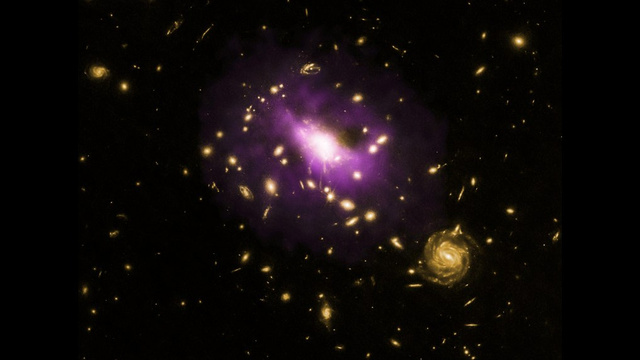This image features a black hole so massive and powerful that that it destroys the stars around it before they can even form.

There are many unusual occurrences in space that mankind constantly seeks to gain knowledge about in an effort to learn about what is beyond our world. From black holes to white dwarfs, the number of unusual events and phenomenon astounds the mind.
And this is what the Chandra Observatory tells about this image:
The black hole is in a galaxy cluster named RX J1532.9+3021 (RX J1532 for short), located about 3.9 billion light years from Earth. The image here is a composite of X-ray data from Chandra revealing hot gas in the cluster in purple and optical data from the Hubble Space Telescope showing galaxies in yellow. The cluster is very bright in X-rays implying that it is extremely massive, with a mass about a quadrillion – a thousand trillion – times that of the sun. At the center of the cluster is a large elliptical galaxy containing the supermassive black hole.
The large amount of hot gas near the center of the cluster presents a puzzle. Hot gas glowing with X-rays should cool, and the dense gas in the center of the cluster should cool the fastest. The pressure in this cool central gas is then expected to drop, causing gas further out to sink in towards the galaxy, forming trillions of stars along the way. However, astronomers have found no such evidence for this burst of stars forming at the center of this cluster . . .
The X-ray image shows two large cavities in the hot gas on either side of the central galaxy. The Chandra image has been specially processed to emphasize the cavities. Both cavities are aligned with jets seen in radio images from the VLA. The location of the supermassive black hole between the cavities is strong evidence that the supersonic jets generated by the black hole have drilled into the hot gas and pushed it aside, forming the cavities.
Shock fronts – akin to sonic booms – caused by the expanding cavities and the release of energy by sound waves reverberating through the hot gas provide a source of heat that prevents most of the gas from cooling and forming new stars.
The cavities are each about 100,000 light years across, roughly equal to the width of the Milky Way galaxy. The power needed to generate them is among the largest known in galaxy clusters. For example, the power is almost 10 times greater than required to create the well-known cavities in Perseus.
Unfortunately, for many of these space phenomenon , we have little proven information and can only hypothesize and theorize on what may really be. However, one thing is for sure– The truth is out there– and one day we may truly understand.












